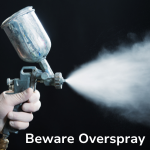Overspray Removal Methods

Clay bar detailing kits can be purchased from motoring accessory stores or online. Several brands are available. Be careful to follow the manufacturer’s instructions, or better still, employ a professional detailer to carry out the overspray removal work.
Clay Bar Detailing
A non-abrasive method that safely removes overspray using a clay bar and a special lubricant to prevent scratching or marking the surface of the paint.
Clay bar detailing is the recommended method of removing Liquasil products from car paintwork, since it does not use any harsh chemicals.
We recommend that a professional car detailer is employed to carry out this work, but it can be done yourself, as long as you take care to continuously lubricate the clay bar during use.
Polishers
Polishers can be used, but care must be taken to use the correct polishing pad.
As polishing equipment can easily be mis-used, we strongly recommend that polishing work is carried out by a professional car detailer, or car body shop, as they will know how to best avoid leaving polishing swirls in your car paintwork.
Chemical Solvents
Chemicals and solvents should not be used to remove Liquasil coatings from vehicles. This is because they might not be compatible with the vehicle’s paintwork and could cause extensive damage.
Step 1: Prepare the Surface
Thoroughly wash and dry the car to remove any loose dirt and debris.
Step 2: Apply Clay Bar
Lubricate the surface with a clay bar lubricant and gently rub the clay bar over the affected areas.
Step 3: Polish
Choose an appropriate polish to buff out any overspray residue.
Step 4: Final Wipe Down
Use a microfibre cloth to wipe down the surface, ensuring all overspray traces are removed.
Understanding the product
Problems With Overspray
Liquasil makes silicone roof coatings that fully bond to the surfaces they are designed for.
Our metal roof coating, Metalseal, is the one that is most commonly spray applied and likely to have been oversprayed.
Unfortunately, there are no short cuts to removing oversprayed Metalseal.
Using chemicals could damage your vehicle’s paintwork, so where possible, use a clay bar detailing product, ideally getting a professional to do this work for you.
How Does Overspray Happen?
When coatings or paint is applied using spraying equipment, the product is atomised as it comes out of the spray gun.
In heavier winds, most applicators will not start or continue spraying, since they know the risk of overspray is present.
However, even on still days, small unforeseen gusts of wind can still occur and they will carry the atomised product until it drops from the air, usually harmlessly onto the ground, but occasionally onto vehicles or even surrounding buildings.
In most cases, the overspray won’t be noticed, but of course, on a car, the paintwork will be noticably to the touch.
How Do I Remove Overspray From Glass?
If overspray is present on glass, for example a windscreen or sunroof, it can usually be removed safely with a plastic scraper and then polished with a normal glass cleaner, or car wash solution.
Can I use WD40 to remove overspray?
There are several online resources that suggest that WD40 can remove overspray and whilst this might be possible, it all depends on whether the WD40 would cause any damage to your car’s paintwork.
We cannot recommend this method, so trying it would be entirely at your own risk.
Who Pays To Remove Overspray From My Vehicle?
In theory, whoever oversprayed your vehicle should be paying to reinstate it.
Installers of our products are all independent businesses and will usually have public liability insurance for this kind of event.
However, when our products are being spray applied, most contractors will inform the building occupier (their client) and usually the occupiers of adjacent buildings, that spraying is taking place and advise them to move any vehicles from the immediate viscinity.
In some cases, they will supply upon request, polythene car covers to use in cases where it is not possible to move cars to a safe distance away from the spraying site.

